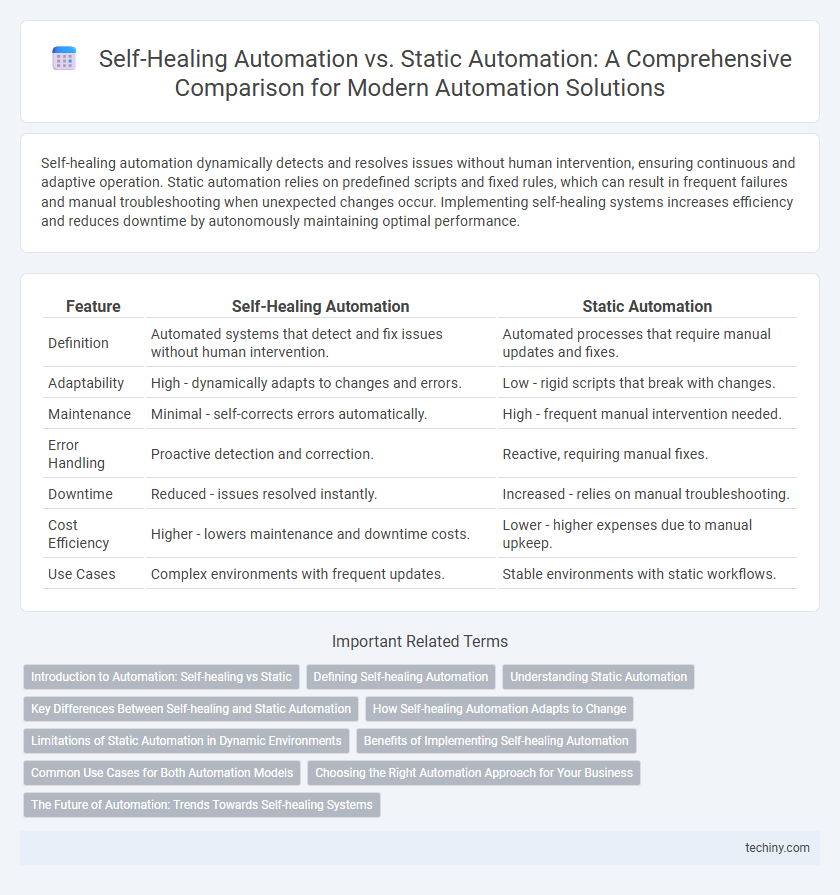Self-healing automation dynamically detects and resolves issues without human intervention, ensuring continuous and adaptive operation. Static automation relies on predefined scripts and fixed rules, which can result in frequent failures and manual troubleshooting when unexpected changes occur. Implementing self-healing systems increases efficiency and reduces downtime by autonomously maintaining optimal performance.
Table of Comparison
| Feature | Self-Healing Automation | Static Automation |
|---|---|---|
| Definition | Automated systems that detect and fix issues without human intervention. | Automated processes that require manual updates and fixes. |
| Adaptability | High - dynamically adapts to changes and errors. | Low - rigid scripts that break with changes. |
| Maintenance | Minimal - self-corrects errors automatically. | High - frequent manual intervention needed. |
| Error Handling | Proactive detection and correction. | Reactive, requiring manual fixes. |
| Downtime | Reduced - issues resolved instantly. | Increased - relies on manual troubleshooting. |
| Cost Efficiency | Higher - lowers maintenance and downtime costs. | Lower - higher expenses due to manual upkeep. |
| Use Cases | Complex environments with frequent updates. | Stable environments with static workflows. |
Introduction to Automation: Self-healing vs Static
Self-healing automation uses AI-driven algorithms and real-time analytics to automatically detect, diagnose, and resolve system issues, minimizing downtime and reducing manual intervention. Static automation relies on predefined scripts and fixed rules that execute repetitive tasks but fail to adapt to unexpected changes or failures without human input. The dynamic nature of self-healing automation enhances operational resilience and efficiency, making it crucial for modern IT and business environments.
Defining Self-healing Automation
Self-healing automation refers to intelligent systems that autonomously detect, diagnose, and resolve issues without human intervention, ensuring continuous operation and minimizing downtime. Unlike static automation, which follows predefined scripts and requires manual troubleshooting, self-healing automation leverages AI, machine learning, and real-time monitoring to adapt and correct anomalies dynamically. This approach significantly enhances system resilience and operational efficiency across IT infrastructure and industrial processes.
Understanding Static Automation
Static automation relies on predefined scripts and rules to perform tasks without adapting to changes or errors during execution, limiting its flexibility and resilience. It requires manual intervention when failures occur, leading to increased downtime and reduced efficiency in dynamic environments. Understanding static automation highlights the need for more advanced approaches like self-healing automation that automatically detect and recover from issues to maintain continuous operation.
Key Differences Between Self-healing and Static Automation
Self-healing automation dynamically detects, diagnoses, and resolves issues in real-time, significantly reducing downtime and manual intervention compared to static automation, which relies on predefined scripts without adaptability. Key differences include self-healing automation's ability to learn from failures and adjust processes autonomously, whereas static automation operates on fixed workflows that require manual updates when errors occur. This adaptability enhances system resilience and efficiency in complex, evolving environments, making self-healing automation more effective for continuous integration and deployment pipelines.
How Self-healing Automation Adapts to Change
Self-healing automation dynamically detects and resolves issues in real-time by leveraging machine learning algorithms and adaptive feedback loops, unlike static automation which relies on predefined scripts vulnerable to failures when conditions change. It continuously monitors system performance and environmental variables, enabling it to modify workflows and recover from unexpected errors without human intervention. This adaptability reduces downtime and maintenance costs, enhancing operational efficiency across complex and evolving IT infrastructures.
Limitations of Static Automation in Dynamic Environments
Static automation struggles in dynamic environments due to its rigid programming, which cannot adapt to unexpected changes or anomalies in real-time processes. This inflexibility leads to frequent downtimes and increased maintenance costs as manual intervention becomes necessary to resolve issues. Self-healing automation mitigates these limitations by leveraging machine learning and AI to detect, diagnose, and correct defects autonomously, ensuring continuous operation and enhanced system resilience.
Benefits of Implementing Self-healing Automation
Self-healing automation significantly reduces downtime by automatically detecting and resolving system issues without human intervention, enhancing operational efficiency. It improves system reliability and performance through continuous monitoring and adaptive responses, leading to faster recovery from failures. Implementing self-healing automation also lowers maintenance costs and minimizes the risk of human error, optimizing overall workflow stability.
Common Use Cases for Both Automation Models
Self-healing automation is widely used in IT infrastructure management for automatic error detection and recovery, reducing downtime and manual intervention. Static automation is commonly implemented in repetitive manufacturing processes where tasks follow fixed, predictable patterns requiring minimal adaptation. Both automation models find common use in business process automation, with self-healing systems enhancing robustness and static automation providing stability in routine workflows.
Choosing the Right Automation Approach for Your Business
Self-healing automation leverages AI and machine learning to detect, diagnose, and resolve issues autonomously, minimizing downtime and operational disruptions. Static automation follows predefined scripts or rules that require manual intervention when errors occur, making it less flexible in dynamic environments. Choosing the right automation approach depends on business complexity, scalability needs, and tolerance for manual oversight, with self-healing systems better suited for evolving processes and static automation fitting simpler, repetitive tasks.
The Future of Automation: Trends Towards Self-healing Systems
Self-healing automation leverages artificial intelligence and machine learning to detect, diagnose, and resolve system issues autonomously, significantly reducing downtime and operational costs compared to static automation, which relies on predefined scripts and manual interventions. Industry leaders project a rapid adoption of self-healing systems in critical sectors such as IT infrastructure, manufacturing, and cloud computing, driven by growing complexity and demand for high availability. The future of automation emphasizes resilience, with predictive analytics and real-time monitoring enabling proactive maintenance and continuous system optimization.
Self-healing Automation vs Static Automation Infographic

 techiny.com
techiny.com